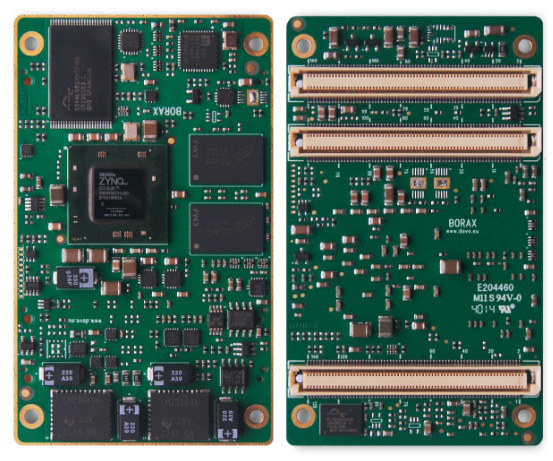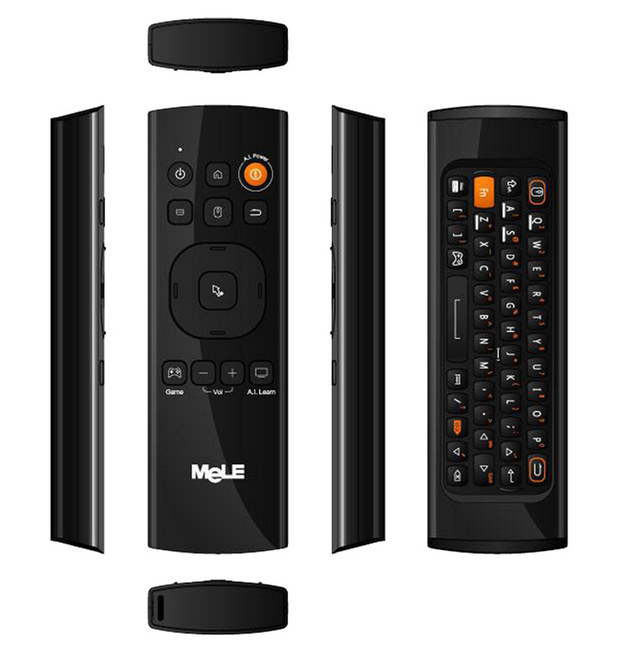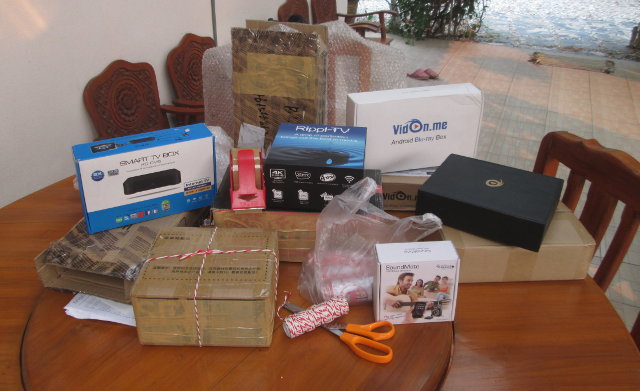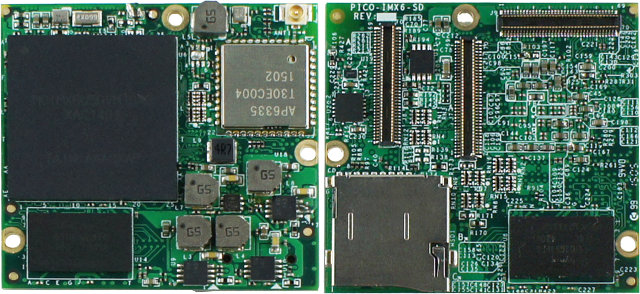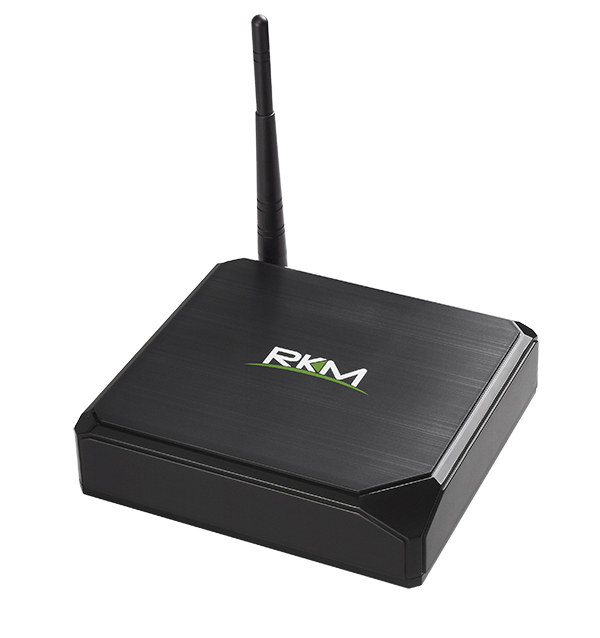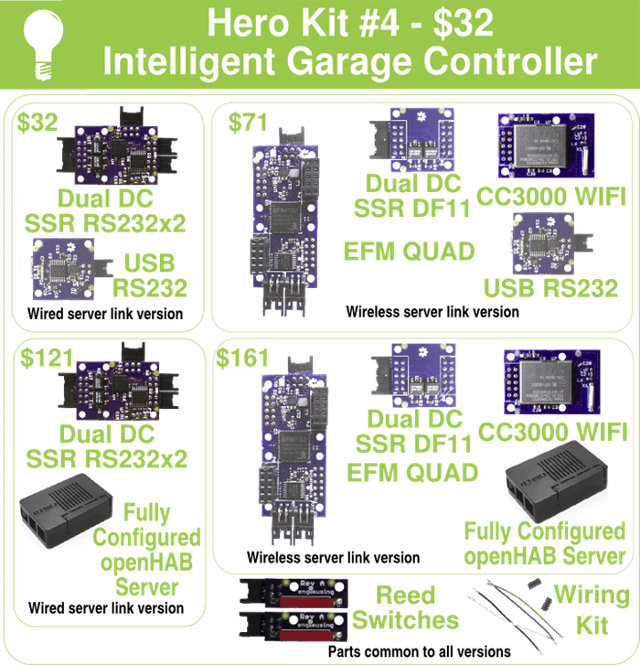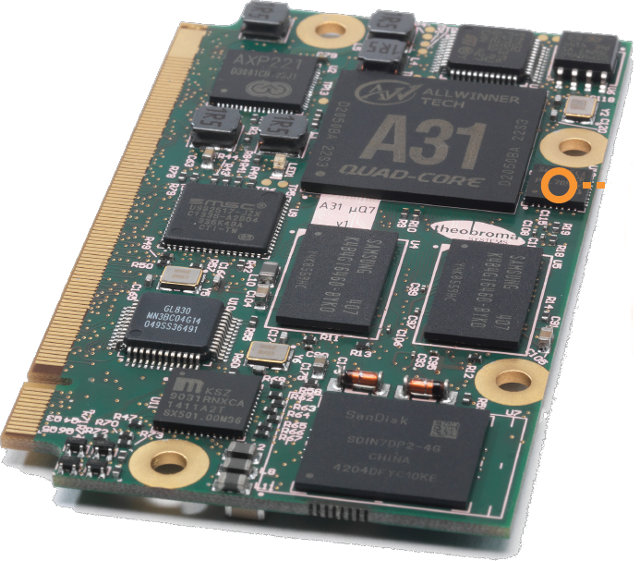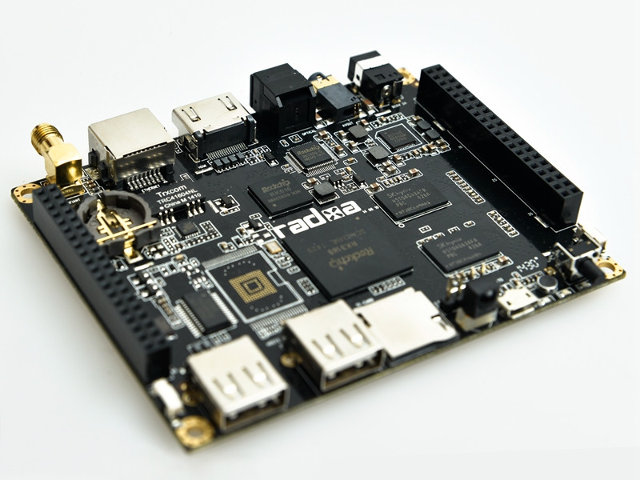There’s a fair amount of low cost boards powered by Xilinx Zynq Z-7010 and Z-7020 with dual core Cortex A9 processor and Artix-7 FPGA, but those who wanted to have PCIe ports or high speed transceivers had to go with the higher-end Xilinx Z-7030/7040/7050 with Kintex-7 FPGA fabric for a much higher cost. But Xilinx introduced Zynq Z-7015 late last year, a low cost Artix-7 FPGA + Cortex A9 SoC that also adds four 6.25Gbps SerDes ports and one PCIe Gen2 x4 integrated block. At least two modules based on the new SoC are currently available with DAVE Embedded Systems’ BORA Xpress and Trenz Electronic TE0715 Series. DAVE Zynq XC7Z015/XC7Z030 BORA Xpress BORA Xpress specifications: SoC Xilinx ZYNQ XC7Z015 dual ARM Cortex-A9 @ up to 866MHz with Artix-7 FPGA with 74K logic cells, 46K LUTs, 92K Flip flops, 380 KB RAM. 32 KB I-cache, 32 KB D-cache, 512 KB L2 […]
MeLE F10 Lite is an Air Mouse with Keyboard using 2x AAA Batteries
MeLE has several models of air mouse, and they are great to use with Android mini PCs, and sometimes I also use these with my regular PC. I started with the original MeLE F10, but then switched to MeLE F10 Deluxe which provides a better pointer control. It’s not perfect as game mode only works with MeLE media devices, I could never make the IR learning function work, and the pointer tends to jump when I press the OK button, so I’m using the mouse button for clicks instead as it does not suffer from this issue. Nevertheless, MeLE F10 Deluxe is still the device I prefer to use during my mini PCs and boards’ reviews. Previous MeLE F10 air mice all comes with a built-in battery, but some people prefer to use standard batteries, and that’s just what the latest MeLE F10 Lite uses, with other features similar to […]
Giveaway Week Winners Announced (March 2015)
The latest Giveaway week has come to an end, and I’m just coming back from the post office, having sent a few Android based TV boxes, a Linux development board, and one wireless audio streamer to the lucky winners. I’ve already announced winners daily in the comment section of each contest, but here’s the list again with the device, winners’ nickname and their country of residence: Nagrace HPH NT-V6 – Rizwan, Canada Vidon Box – bazsi, Romania RipplTV – driv3l, USA Freescale SABRE Lite – biasio95, Italy Vidon.me AV200 – cityF, Portugal HD18T – Sean, Canada SoundMate WM201 – Orel, France So people from Canada got lucky, but still no winner from Asia or Oceania. The parcel have been send via registered Small Packet Airmail, all the winners should receive them in a few weeks, and certainly I hope they’ll have fun enjoy with their devices. If you haven’t won […]
TechNexion Introduces Intel Edison Compatible PICO-iMX6 SoM and DWARF Board
Intel Edison is a board made for wearables featuring an SoC with Intel Atom and Quark CPU cores. TechNexion, an embedded systems company based in Taiwan, has decided to make a mechanically and electrically compatible system-on-module featuring Frescale i.MX6 Solo or Duallite ARM Cortex A9 processor called PICO-iMX6. The company is also providing a PICO-DWARF baseboard that’s both compatible with PICO-iMX6 SoM and Edison board. DWARF stands for “Drones, Wearables, Appliances, Robotics and Fun”, so that pretty much explains what the platform is for. PICO-iMX6 System-on-Module Two version of the modules are available: PICO-iMX6-SD and PICO-iMX6-EMMC, the former with a micro SD slot for storage, and the latter a 4GB eMMC. Both share the followings specifications: SoC – Freescale i.MX6 Solo / Duallite single/dual core ARM Cortex A9 @ 1Ghz with Vivante GC880 3D GPU and Vivante GC320 2D GPU (Composition) System Memory – 512MB or 1GB DDR3 Storage – […]
Rikomagic MK80LE (Linux Edition) Octa-core Ubuntu mini PC
Allwinner A80 based Rikomagic MK80 Android TV box, now has a Linux sibling with Rikomagic MK80LE (Linux Edition) running Ubuntu 14.04, and allegedly supports 2D/3D graphics acceleration, and hardware video decoding. Two versions are available MK80LE with 2GB RAM & 16GB Flash, and MK80LE Plus with 4GB RAM & 32GB flash. The hardware specs are the same as the Android versions (and Tronsmart Draco AW80 Meta / Telos): SoC – AllWinner Ultra Core A80 4x Cortex 15 @ 2016 MHz, 4x Cortex A7 @ 1320 MHz big.LITTLE processor with Imagination Technologies PowerVR GC6230 GPU with support for OpenGL ES 1.1/2.0/3.0, Directx 9.3 System Memory – 2GB (MK80LE), or 4GB (MK80LE Plus) RAM Storage – 16 GB (MK80LE) or 32GB (MK80LE Plus) eMMC, external SATA port (via a USB 2.0 bridge), and micro SD slot up to 64GB Video Output – HDMI 1.4 + AV port Audio Output – HDMI, AV […]
Engimusing DIY Home Automation Modules Are Managed with openHAB installed on ODROID-C1 Board (Crowdfunding)
Engimusing has launched a crowdfunding campaign on Kickstarter for their home automation solutions comprised of tiny modules (20x20mm) based on Silicon Labs Gecko EFM32 MCUs, some sensor modules and a server based on ODROID-C1 board and enclosure pre-installed and configured with openHAB open source home automation software. There are not that many technical details about the EFM32 modules, but they come into two variants: standalone & DF11-10 I/O, the latter allowing you to vertically stack multiple modules. This video shows how DF11-10 IO connectors work. The modules are said to be programmable with the Arduino IDE. The openHAB server is a standard ODROID-C1 board (Amlogic S805, 1GB RAM) with 4GB flash (eMMC or micro SD), and a black enclosure. If you value your money more than your time, and/or already have another computer or board (Raspberry Pi, BeagleBone Black…) that runs Linux, you could also install and configure openHAB by […]
Theobroma Systems Introduces A31-μQ7 Micro QSeven System-on-Module Powered by Allwinner A31 Processor
Most standardized system-on-modules for embedded and industrial applications are still based on established Silicon vendors such as Freescale, Texas Instruments or Atmel, simply because documentation and support is generally much better than relatively new SoC vendors, most of the time China-based, such as Allwinner or Rockchip. That does not mean nobody is using Rockchip or Allwinner on their modules, as shown recently with Olimex RK3188-SOM, and previously with an Allwinner 10 CoM. But Theobroma Systems, an Austrian based engineering services and embedded systems solutions company, may have a first with a Micro Qseven compliant modules powered by Allwinner A31, simply called A31-μQ7. A31-μQ7 module specifications: SoC – Allwinner A31 quad core ARM Cortex A7 processor up to 1.2GHz with 256KB L1 cache / 1024KB L2 cache, and PowerVR SGX544MP2 GPU System Memory – Up to 2GB DDR3 Storage – Up to 64GB eMMC, Up to 16MB SPI NOR flash, On-board […]
Radxa Rock Lite Board Price Drops to $39
When the new Radxa Rock Lite was announced for $59 in September 2014, it was one of the most inexpensive quad core ARM Linux development board available on the market. But ODROID-C1 board in December 2014, and especially Raspberry Pi 2 board in February 2015 changed all that, as these two quad core boards sell for $35 before shipping and taxes. So the company has now decided to drop the price to $39 for the Radxa Rock Lite board. Let’s remind us of Radxa Rock Lite specifications: SoC – Rockchip RK3188 ARM Cortex-A9 quad core @ 1.6Ghz + Mali-400 MP4 GPU System Memory – 1GB DDR3 @ 800Mhz Storage – micro-SD SDXC up to 128GB Video Output – HDMI 1.4 up to 1080p@60hz, and AV output. LVDS interface. Connectivity – 10/100M Ethernet port, WiFi 150Mbps 802.11b/g/n with antenna Audio I/O – Audio S/PDIF, headphone jack Camera – CSI interface USB […]


